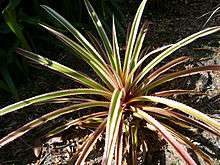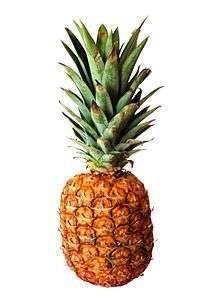Ananas bracteatus
| Ananas bracteatus | |
|---|---|
 | |
| Ananas bracteatus fruit | |
| Scientific classification | |
| Kingdom: | Plantae |
| (unranked): | Angiosperms |
| (unranked): | Monocots |
| (unranked): | Commelinids |
| Order: | Poales |
| Family: | Bromeliaceae |
| Subfamily: | Bromelioideae |
| Genus: | Ananas |
| Species: | A. bracteatus |
| Binomial name | |
| Ananas bracteatus | |
| Synonyms[1] | |
| |
Ananas bracteatus (common name, red pineapple) is a species of plant. It is native to South America (Brazil, Bolivia, Argentina, Paraguay, Ecuador).[1][2][3]
Ananas bracteatus is grown as an ornamental plants for its decorative red fruit. The leaves are long with sharp spines, so it can be used as a protective hedge for home security. In colder places they can be grown indoors as a houseplant. It grows throughout Brazil at elevations of 140 to 320 metres (450–1,050 ft).
Description

Ananas bracteatus is a large terrestrial species of bromeliad that grows 100 centimetres (40 in) dark green leaves that fade red to pink when exposed to sunlight.[4] The long spiny leaves are characterized by "broad, cream and green, longitudinal stripes that are suffused with pink when grown in good light."[5] When it flowers it blossoms typical pineapple fruit; it is similar to Ananas comosus but far more prolific.
References
- 1 2 Kew World Checklist of Selected Plant Families
- ↑ da Costa, A.F. & Wendt, T. (2007). Bromeliaceae na região de Macaé de Cima, Nova Friburgo, Rio de Janeiro, Brasil. Rodriguésia; Revista do Instituto de Biologia Vegetal, Jardim Botânico e Estaçao Biologica do Itatiaya 58: 905-939.
- ↑ Versieux, L.M., Wendt, T., Batista Louzada, R. & das Graças Lapa Wanderley, M. (2008 publ. 2009). Bromeliaceae da Cadeia do Espinhaço. Megadiversidade 4: 98-110.
- ↑ Kramer, Jack (1976). Bromeliads The Colorful House Plants. Litton Educational Publishing, Inc. pp. 33; 100. ISBN 0-442-24518-1.
- ↑ Padilla, Victoria (1973). Bromeliads. New York: Crown Publishers. p. 32. ISBN 0517562413.
The red mountain pineapple, Ananas bracteatus, is a wild species from cooler altitudes in the Andes.
It grows vigorously and fruits outdoors in any warm, sunny spot in Northland and Auckland. Its reddish leaves are very spiky. As in VERY SPIKY – weeding around them is a blood sport. So it's best to plant these through weedmat or a deep mulch to prevent weeds altogether. It is a beautiful looking plant. As the fruit develops it is brilliant red and each segment of the young fruit produces a vivid purple flower. The redness of the fruit gradually fades as it matures. It is not edible until every trace of red has gone and the skin is pale yellow. But, like any pineapple, you can smell the powerful sweet aroma when it's ready to cut. This one takes about 18 months to produce ripe fruit outdoors here.
An unripe red mountain pineapple, Ananas bracteatus, already pupping. Photo: Russell Fransham
There is a beautiful variegated form of the red pineapple available called Ananas bracteatus 'Tricolor', which makes a spectacular houseplant or patio tub plant. Its fruit is also edible, though are usually smaller.
Propagating pineapples from the shoot on top of the fruit is best done in the spring or summer. Remove the shoot from the fruit by screwing it round and round until it comes free, with no flesh attached.
Let it dry out for a few days then remove the bottom few layers of scale-leaves that cover the young roots, which may already be 2cm long. Plant the shoot in sand or coarse potting mix, holding it upright with short stakes. Or you can sit it upright in the mouth of a glass of water containing a few drops of bleach, with the root end touching the water until the roots have grown a bit before planting it in the soil.
